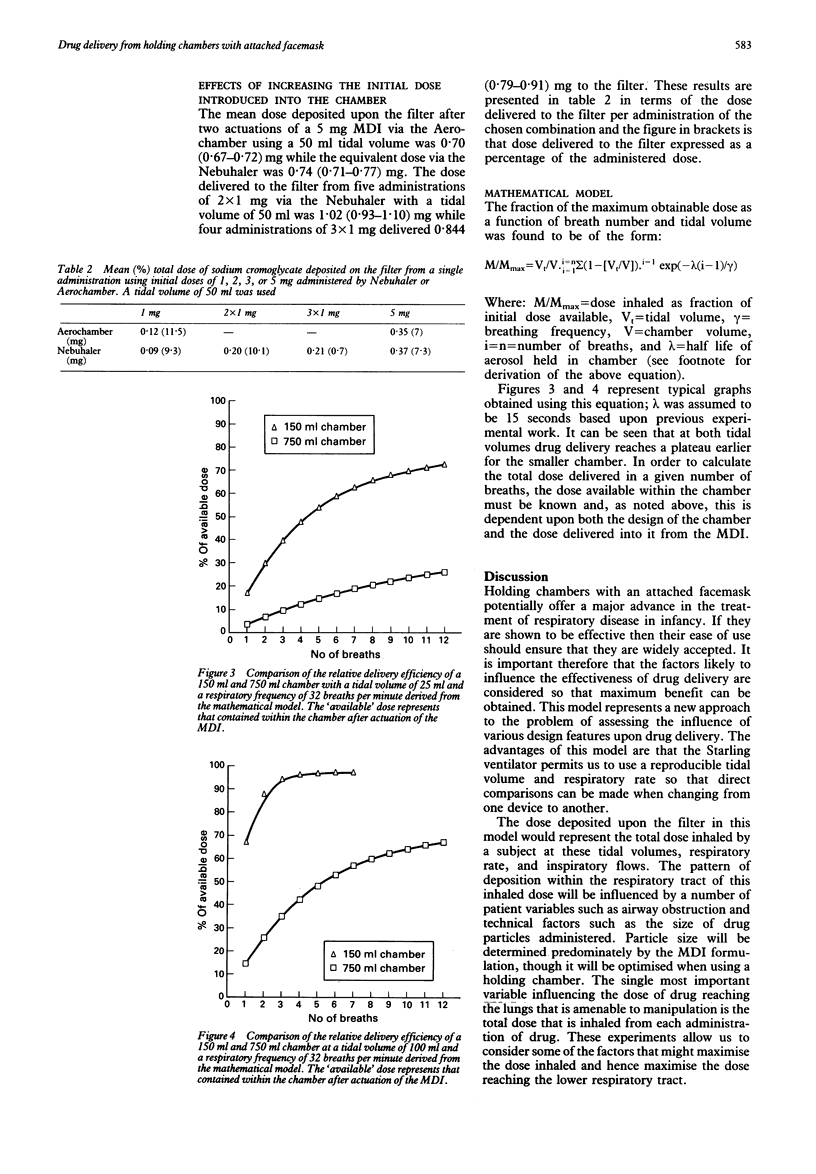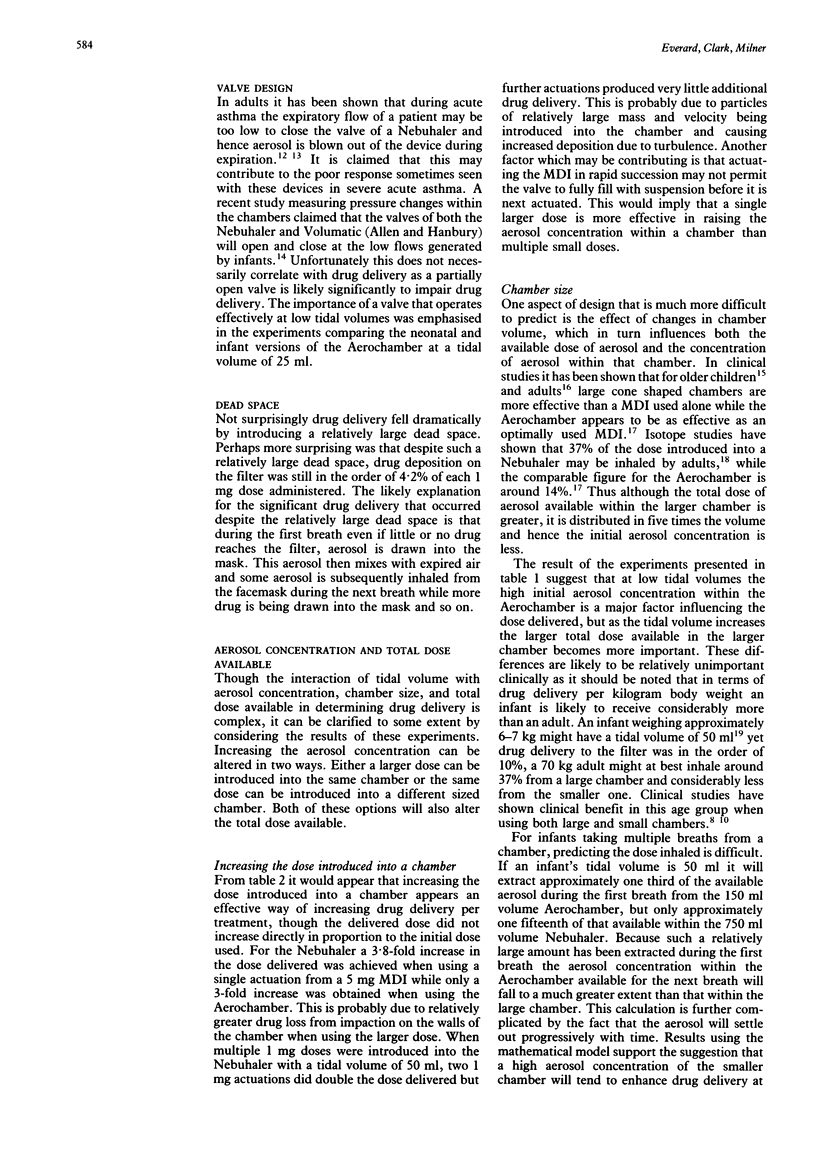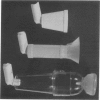Abstract
There is much interest in the use of holding chambers with an attached facemask to deliver aerosols from metered dose inhalers to infants. In order to study the influence of various design factors on the dose inhaled at different tidal volumes, a model was constructed in which a Starling ventilator was used to generate an inspiratory/expiratory cycle across a filter. Sodium cromoglycate was administered via a Nebuhaler and mask, Aerochamber and mask, and a coffee cup using tidal volumes of 25, 50, and 150 ml and the dose deposited upon the filter after six breaths was assayed using an ultraviolet spectrophotometric method. At the lowest tidal volume the high aerosol concentration in the smaller chamber enhanced drug delivery while at the highest tidal volume delivery was greatest from the larger chamber reflecting the larger dose available. Multiple breaths ensured that the dose inhaled per kilogram from each chamber was relatively large and also permitted significant drug delivery despite the introduction of a relatively large dead space between valve and filter. The dose delivered was increased by increasing the dose introduced into the chamber though not proportionately. These devices appear likely to deliver significant quantities of aerosol to infants, though drug delivery may be enhanced by the use of an appropriate valve.
Full text
PDF





Images in this article
Selected References
These references are in PubMed. This may not be the complete list of references from this article.
- Beasley C. R., O'Donnell T. V. Pear shaped spacer nebuhaler compared with nebulised solution for terbutaline administration in acute severe asthma. N Z Med J. 1985 Oct 9;98(788):854–855. [PubMed] [Google Scholar]
- Bisgaard H., Munck S. L., Nielsen J. P., Petersen W., Ohlsson S. V. Inhaled budesonide for treatment of recurrent wheezing in early childhood. Lancet. 1990 Sep 15;336(8716):649–651. doi: 10.1016/0140-6736(90)92147-a. [DOI] [PubMed] [Google Scholar]
- Bisgaard H., Ohlsson S. PEP-spacer: an adaptation for administration of MDI to infants. Allergy. 1989 Jul;44(5):363–364. doi: 10.1111/j.1398-9995.1989.tb00459.x. [DOI] [PubMed] [Google Scholar]
- Conner W. T., Dolovich M. B., Frame R. A., Newhouse M. T. Reliable salbutamol administration in 6- to 36-month-old children by means of a metered dose inhaler and Aerochamber with mask. Pediatr Pulmonol. 1989;6(4):263–267. doi: 10.1002/ppul.1950060410. [DOI] [PubMed] [Google Scholar]
- Cox I. D., Wallis P. J., Apps M. C. Potential limitations of a conical spacer device in severe asthma. Br Med J (Clin Res Ed) 1984 Apr 7;288(6423):1044–1044. doi: 10.1136/bmj.288.6423.1044. [DOI] [PMC free article] [PubMed] [Google Scholar]
- Cushley M. J., Lewis R. A., Tattersfield A. E. Comparison of three techniques of inhalation on the airway response to terbutaline. Thorax. 1983 Dec;38(12):908–913. doi: 10.1136/thx.38.12.908. [DOI] [PMC free article] [PubMed] [Google Scholar]
- Dolovich M., Ruffin R., Corr D., Newhouse M. T. Clinical evaluation of a simple demand inhalation MDI aerosol delivery device. Chest. 1983 Jul;84(1):36–41. doi: 10.1378/chest.84.1.36. [DOI] [PubMed] [Google Scholar]
- Everard M. L., Clark A. R., Milner A. D. Drug delivery from jet nebulisers. Arch Dis Child. 1992 May;67(5):586–591. doi: 10.1136/adc.67.5.586. [DOI] [PMC free article] [PubMed] [Google Scholar]
- Gleeson J. G., Price J. F. Nebuhaler technique. Br J Dis Chest. 1988 Apr;82(2):172–174. doi: 10.1016/0007-0971(88)90039-3. [DOI] [PubMed] [Google Scholar]
- Henry R. L., Milner A. D., Davies J. G. Simple drug delivery system for use by young asthmatics. Br Med J (Clin Res Ed) 1983 Jun 25;286(6383):2021–2021. doi: 10.1136/bmj.286.6383.2021. [DOI] [PMC free article] [PubMed] [Google Scholar]
- Johnson M. A., Newman S. P., Bloom R., Talaee N., Clarke S. W. Delivery of albuterol and ipratropium bromide from two nebulizer systems in chronic stable asthma. Efficacy and pulmonary deposition. Chest. 1989 Jul;96(1):6–10. doi: 10.1378/chest.96.1.6. [DOI] [PubMed] [Google Scholar]
- Levison H., Reilly P. A., Worsley G. H. Spacing devices and metered-dose inhalers in childhood asthma. J Pediatr. 1985 Nov;107(5):662–668. doi: 10.1016/s0022-3476(85)80389-9. [DOI] [PubMed] [Google Scholar]
- Mallol J., Barrueto L., Girardi G., Toro O. Bronchodilator effect of fenoterol and ipratropium bromide in infants with acute wheezing: use of MDI with a spacer device. Pediatr Pulmonol. 1987 Sep-Oct;3(5):352–356. doi: 10.1002/ppul.1950030511. [DOI] [PubMed] [Google Scholar]
- O'Callaghan C., Milner A. D., Swarbrick A. Spacer device with face mask attachment for giving bronchodilators to infants with asthma. BMJ. 1989 Jan 21;298(6667):160–161. doi: 10.1136/bmj.298.6667.160. [DOI] [PMC free article] [PubMed] [Google Scholar]
- Polgar G., Weng T. R. The functional development of the respiratory system from the period of gestation to adulthood. Am Rev Respir Dis. 1979 Sep;120(3):625–695. doi: 10.1164/arrd.1979.120.3.625. [DOI] [PubMed] [Google Scholar]
- Sennhauser F. H., Sly P. D. Pressure flow characteristics of the valve in spacer devices. Arch Dis Child. 1989 Sep;64(9):1305–1307. doi: 10.1136/adc.64.9.1305. [DOI] [PMC free article] [PubMed] [Google Scholar]
- Shore S. C., Weinberg E. G. Administration of bronchodilator to young children. Br Med J. 1973 Aug 11;3(5875):350–350. doi: 10.1136/bmj.3.5875.350-d. [DOI] [PMC free article] [PubMed] [Google Scholar]



